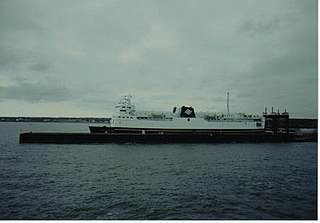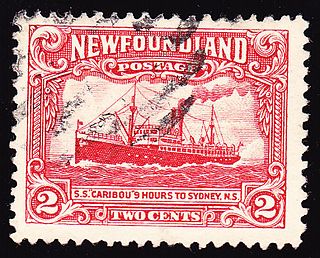
Cabot Strait is a strait in eastern Canada approximately 110 kilometres wide between Cape Ray, Newfoundland and Cape North, Cape Breton Island. It is the widest of the three outlets for the Gulf of Saint Lawrence into the Atlantic Ocean, the others being the Strait of Belle Isle and Strait of Canso. It is named for the Genoese explorer Giovanni Caboto.

Marine Atlantic Inc. is an independent Canadian federal Crown corporation which is mandated to operate ferry services between the provinces of Newfoundland and Labrador and Nova Scotia.

Channel-Port aux Basques is a town at the extreme southwestern tip of Newfoundland fronting on the western end of the Cabot Strait. A Marine Atlantic ferry terminal is located in the town which is the primary entry point onto the island of Newfoundland and the western terminus of the Newfoundland and Labrador Route 1 in the province. The town was incorporated in 1945 and its population in the 2021 census was 3,547.

CN Marine was a Canadian ferry company headquartered in Moncton, New Brunswick.

The Newfoundland Railway operated on the island of Newfoundland from 1898 to 1988. With a total track length of 906 miles (1,458 km), it was the longest 3 ft 6 in narrow-gauge railway system in North America.
Terra Transport (TT) was the name for the Newfoundland Transportation Division, a wholly owned subsidiary of Canadian National Railway (CN), created in 1979 as a means to organize the company's operations on Newfoundland.

North Sydney is a former town and current community in Nova Scotia's Cape Breton Regional Municipality.

M/V William Carson was a CN Marine passenger/vehicle icebreaker ferry named in honour of Newfoundland colonial politician William Carson.

MV Joseph and Clara Smallwood was a Marine Atlantic passenger/vehicle ferry which operated between Newfoundland and Cape Breton Island in eastern Canada. She is named after former Newfoundland premier Joseph R. Smallwood and his wife Clara.

MV John Hamilton Gray was an icebreaking railway, vehicle, and passenger ferry which operated across the Abegweit Passage of Northumberland Strait, connecting Port Borden to Cape Tormentine between 1968–1997.

SS Caribou was a Newfoundland Railway passenger ferry that ran between Port aux Basques, in the Dominion of Newfoundland, and North Sydney, Nova Scotia between 1928 and 1942. During the Battle of the St. Lawrence the ferry participated in thrice-weekly convoys between Nova Scotia and Newfoundland. A German submarine attacked the convoy on 14 October 1942 and Caribou was sunk. She had women and children on board, and many of them were among the 137 who died. Her sinking, and large death toll, made it clear that the war had really arrived on Canada's and Newfoundland's home front. Her sinking is cited by many historians as the most significant sinking in Canadian-controlled waters during the Second World War.
German submarine U-69 was the first Type VIIC U-boat of Nazi Germany's Kriegsmarine during World War II. This meant that compared to previous U-boats, she could travel further afield for longer, with a payload of eleven torpedoes, an 8.8 cm (3.5 in) deck gun for smaller vessels and a flak gun for use against aircraft. U-69 was very successful, sinking over 72,000 gross register tons (GRT) of Allied shipping in a career lasting two years, making her one of the longest surviving, continuously serving, U-boats. Her most notable attack was on the civilian ferry SS Caribou, which sank off the coast of Newfoundland in October 1942, killing 137 men, women and children. She was rammed and sunk by HMS Fame on 17 February 1943.

The MV Vacationland is a Canadian RORO ferry that operated across the Northumberland Strait between the ports of Cape Tormentine, New Brunswick and Port Borden, Prince Edward Island.

MV Holiday Island is a Canadian RORO ferry that operates across the Northumberland Strait between the ports of Wood Islands, Prince Edward Island and Caribou, Nova Scotia. The vessel is owned by the Government of Canada and is managed and operated by Northumberland Ferries Limited.

The MV Leif Ericson is a commercial passenger/vehicle ferry in service with the Canadian operator Marine Atlantic. She is currently the oldest vessel in the Marine Atlantic fleet. She was built along with two sister ships by Fosen Mekaniske Verksteder, Norway in the early 1990s. These two are Oslofjord and Patria Seaways.

MV Atlantic Vision is a fast ro-pax ferry owned by the Estonian ferry company Tallink, under charter to Canadian operator Marine Atlantic. In February 2015, Marine Atlantic announced that the lease on the vessel had been renewed until November 2017 for a cost of Can$40 million. It was subsequently extended again, and the vessel is under Marine Atlantic control through November 2019. As of 2016 Atlantic Vision operates on Marine Atlantic's services between North Sydney, Nova Scotia, and the Newfoundland ports of Channel-Port aux Basques and Argentia, Placentia.

MV Abegweit were icebreaking railway, vehicle, and passenger ferries which operated across the Abegweit Passage of Northumberland Strait, connecting Borden-Carleton, Prince Edward Island to Cape Tormentine, New Brunswick. There were two vessels named Abegweit that serviced this route between 1947 and 1997.

MV Blue Puttees is a Ro-Pax passenger/vehicle ferry operated by Marine Atlantic between the islands of Newfoundland and Cape Breton in eastern Canada. She is named after the nickname of the Royal Newfoundland Regiment.
MV Highlanders is a Ro-Pax passenger/vehicle ferry operated by the Canadian Crown corporation Marine Atlantic. She operates between the islands of Newfoundland and Cape Breton in eastern Canada and is named after several Nova Scotian infantry regiments which fought in the first and second world wars.

The MV Patrick Morris was a Canadian National Railway (CN) train ferry that sank on her run from North Sydney, Nova Scotia to Port aux Basques, Newfoundland during a storm in the early morning hours of 20 April 1970 while responding to a mayday call from the Newfoundland-based herring seiner FV Enterprise. The ship's Captain Roland Penney was given permission to leave North Sydney ahead of schedule to assist the wood-hulled fishing vessel in distress. No passengers were aboard the Patrick Morris when she set sail shortly before midnight for the rescue mission on 19 April.


















